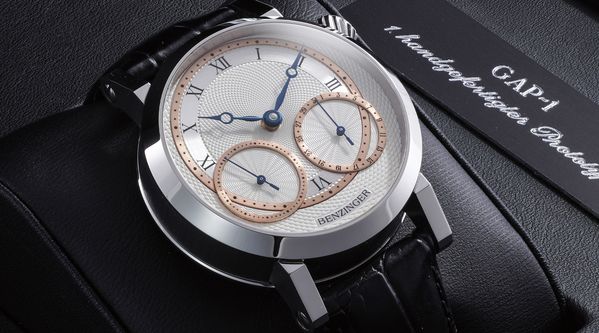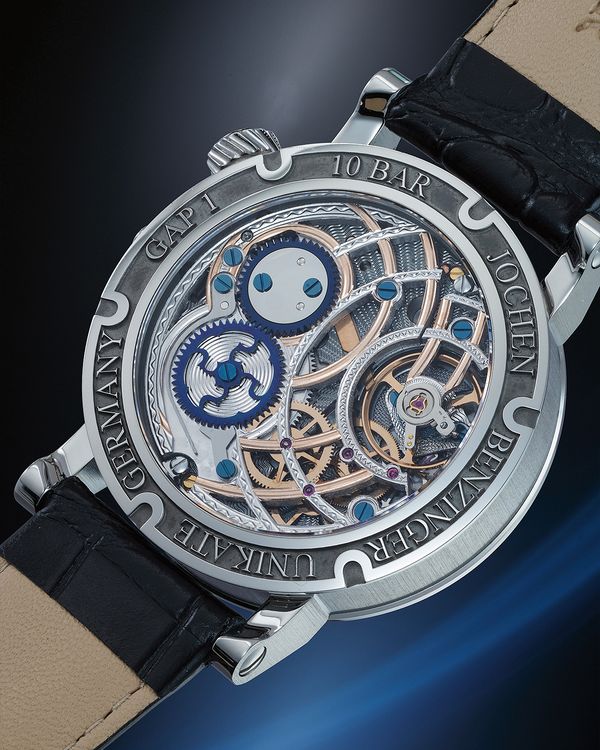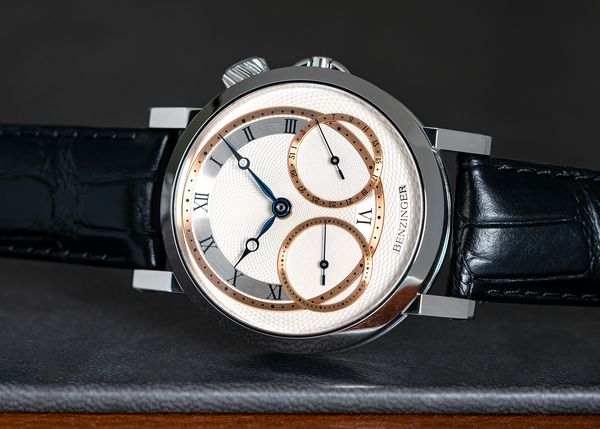Our first live auction of 2023, the PHILLIPS Geneva Watch Auction: XVII, takes place on May 13 and 14, at La Réserve Genève. The auction includes more than 200 of the world's finest watches – and though we are loath to boast, we truly think it's one of the best catalogs we've ever assembled. We'll be spotlighting a number of the most interesting lots and stories featured in the sale over the next month, including the Benzinger GAP 1 "Prototype" featured in this story.
– By Logan Baker
There’s a whole world of independent watchmakers to appreciate outside of Switzerland. Although many international watchmakers do end up relocating to Switzerland simply to be closer to the endless educational and collaborative opportunities, in addition to a larger supplier network, there are still many makers that prefer to make a go of it in their homeland.
Germany, Switzerland’s neighbor to the northeast, is home to a number of major watchmakers, both independent and those owned by larger international conglomerates. A. Lange & Söhne and Glashütte Original fall in the latter, while brands such as Nomos Glashütte, Moritz Grossmann, Mühle Glashütte, and Lang & Heyne fit the bill of the former (albeit at vastly different price points).
If you’re familiar with German watchmaking, you likely know most, if not all of those brands, so you might already realize that they’re all based out of Saxony, either in Glashütte or in nearby Dresden. The Saxon brands are what most collectors think of when German watchmaking comes up in discussion, but as great as they are, they only show a limited perspective of the full scope of German watchmaking.
In fact, to fully understand Germany’s horological history, one must depart Saxony entirely and drive about six hours southwest to the city of Pforzheim, on the edge of the Black Forest, in the federal state of Baden-Württemberg. Pforzheim is known as Germany’s Golden City (Goldstadt) for its long history as a hub for the watch and jewelry trades. Some of the well-known watch companies still based in the area are Hanhart, Stowa, Laco, and Junghans, but perhaps the area’s best known horological export is actually the cuckoo clock – which, yes, was invented in the Black Forest region, and not in Switzerland.
Those watch brands – and even many of the cuckoo clock makers in the area – now favor a more industrial and international approach to sourcing and assembly, but there’s at least one individual still working in Pforzheim that prefers to do things the old-fashioned way. His name is Jochen Benzinger.

Since 1978, Benzinger has worked in Pforzheim focused almost entirely on a single craft: engine-turning, also known as guilloché, using exclusively hand-operated machines that are frequently over a century old.
Benzinger is one of the finest guillocheurs and engravers working anywhere in the world today. He’s made dials for IWC, Chronoswiss, Glashütte Original, Moritz Grossmann, Staudt, and countless other watch brands that he’s unable to name due to NDAs. He’s created guilloché rotors for Christiaan van der Klaauw. Rolls-Royce even enlisted him a few years ago to handle the guilloché work on the dashboard clocks of select vehicles in the eighth generation of the Phantom range. And for more than 30 years, Fabergé has called on Benzinger to handle the engraving and guilloché work on their legendary Imperial eggs. Benzinger is a craftsman in the truest sense, and his decades of experience in engine turning and engraving have elevated him to the highest level in his field, even if today is your first time hearing about him.
And like any true craftsperson, Benzinger has always favored a flexible approach to his work. In fact, there isn’t just a singular Benzinger brand today; his watches are split under three different companies. Benzinger, by itself, is his primary business. His time-only watches in stainless steel with hand-guilloché dials and hand-engraved and skeletonized manual-wind movements (primarily sourced from ETA) can start at a little over $8,000 USD, and eventually reach up to the mid-$20,000 range (or beyond) featuring more complicated designs in precious metals. Benzinger also offers a detailed customization program where he’ll create pretty much anything a client can dream up in the form of a unique piece with sliding scale pricing. It typically takes six to nine months to complete a standard customization project.
But that’s not all, Benzinger has two additional labels that he created with longtime friends and colleagues. There’s Jaeger & Benzinger, where Benzinger works with Kay Jaeger, a well-known advocate for German craftsmanship, to create special watches at a slightly more affordable price point (starting around $4,500 USD), yet still emphasize hand craft with the use of genuine engine-turned guilloché and hand-engraving, but to a slightly less ornate degree than what you'd find in Benzinger's solo line.
And finally, there’s Grieb & Benzinger, a partnership that began in 2017 and focuses on very high-end, small-scale projects that include more complicated pieces (such as a tourbillon with remontoire), as well as extreme customization projects.

Altogether, Benzinger produces approximately 50 watches per year across all three brands, with his monobrand collection taking up the largest portion of that total, and Grieb & Benzinger the smallest. He also creates approximately 100 to 150 dials (or other engraved/guilloché surfaces) per year for outside partners. At the end of the day, no matter what project you're working on with him, Benzinger's business is built all around handcraft.
Benzinger began his career as an engraver of gold jewelry in the late 1970s. At that time, there were more than 30,000 individuals working in Pforzheim’s watch and jewelry sector. Today, there are approximately 2,000 today. Benzinger, however, seized opportunity out of those disheartening numbers. As the various factories and workshops around his hometown gradually closed over the decades, Benzinger purchased the liquidated machines, tooling, and lathes. As of today, he has around 20 different machines in his workshop, where he still does most of the work himself on every dial and movement.
Although he started his guilloché career working on gold jewelry, Benzinger credits one man with giving him his big break into the watch business.
“Gerd-Rudiger Lang asked me to do the first hand-guilloché dials at Chronoswiss,” he says. "At the time, they were only doing stamped styles. He took me on, and he put my name on the watch: ‘Dial by Benzinger.’ That was the first time anything like that ever happened to me as a young man.”
It's not entirely a one-man show these days. Benzinger currently has two employees based in his workshop that assist him on various projects, particularly ones involving skeletonization. He also keeps the local Pforzheim watchmakers busy with repair and assembly requests. However, for the most part, a watch "by Benzinger" is exactly what it reads on the tin.
Benzinger believes his craft-oriented approach has earned him consistent business over the years from all segments of the watch collector market.
“We reach all types of collectors,” he says. “I have some collectors that can buy a watch for €200,000 or €300,000, and then I have some collectors that can only spend about €5,000 on a watch. I think it's because of all the work I’ve put into my dials over the years; people recognize the quality.”
Quality is forever, but Benzinger did begin to feel a slight desire to evolve his business to the next level a few years ago.
Now in his early sixties, he was mostly happy and did not (and still does not) want to extend his business too far, but he wanted to offer his core Benzinger clients something new. So he set his eyes on one of the few things he had yet to tackle in his career – a proprietary movement.
“At the beginning, I was happy to build my own brand, my own watches, with the typical Benzinger look,” he says. "I didn't care much about the movement inside. For me it was more about the handwork, and the craft of it all. Only the last four or five years did I begin to wish I could have my own movement.”
So Benzinger called in some help. He reached out to Richard and Maria Habring, of Habring², to see if they might be interested in a potential collaboration. It wasn't exactly a cold call. Benzinger shares the same Australian distribution partner with the Habrings, and they even teamed up once before on a highly limited five-minute repeater. The Habrings quickly agreed to Benzinger's proposal, and the "GAP 1" project was officially born.
GAP 1 stands for “German-Austrian Partnership,” highlighting the home countries of the two collaborators, and it was officially unveiled last year. Inspired by the work of Abraham-Louis Breguet and George Daniels, the GAP 1 is a limited edition of 50 watches with an off-centered time display with hours and minutes on a larger applied display ring and two overlapping display rings that indicate running seconds (near eight o’clock), and the date (near four o’clock). A total of six different dial configurations are available for clients to choose from, ranging from various guilloché patterns, rhodium plating, and lacquer coatings, as well as options for blued or gilt colorations on the hands and the applied rings for the time displays.
The stainless steel case is also a brand-new design for Benzinger, featuring smaller dimensions of 39mm × 11.5mm instead of his standard 42mm profile, a decision he made based on customer feedback. The case itself is milled at a local workshop in Pforzheim, and it features a mix of brushed and polished surfaces and downward-facing lugs fitted with a screw-in strap bar. Interestingly, the crown used to set the time is positioned at the traditional two o’clock position, while a pusher enabling rapid date correction is located at three o’clock.
The movement inside, developed by Richard and Maria Habring, with feedback from Benzinger, is a hand-wound 30mm × 5.1mm caliber that runs in 19 jewels at 4 Hz with a 48-hour power reserve. Benzinger says it’s regulated to chronometer precision, but it’s the decoration of the movement that should capture more attention than the specs sheet. The movement is completely hand-skeletonized, all the way down to the ratchet wheel, and every visible bridge and plate is hand-engraved using a rose engine with an elaborate wave-like pattern. The baseplate is rhodium plated, while certain bridges are plated in rose gold. All the screws are heat-blued, as are the ratchet and crown wheel.
Benzinger says it takes a full day of work for him to finish a single guilloché dial for the GAP 1, and completing the decoration of a single movement takes up to 80 hours. And despite the proprietary caliber and the high level of handwork that goes into each watch, the GAP 1's list price is still eminently reasonable, starting at USD $12,860. Sure, it's higher than the entry point of his standard Benzinger line, but there are thousands and thousands of watches using ébauche movements and that are machine-assembled and -finished from big-label brands that collectors line up to buy. It’s hard to think of a watch from anyone near this price point with a comparable level of decoration, in addition to a proprietary movement design.
The GAP 1 was announced in 2022 as a 50-piece limited edition, which will take up a significant amount of Benzinger’s production capacity for 2022 and 2023. What he doesn’t plan to do, however, is focus solely on this new segment of his business.
Benzinger confirms he’ll continue to use ETA-based movements for most of his mainline Benzinger pieces, as well as in the more approachable Jaeger & Benzinger collection. The GAP 1 is just a new offering that allows Benzinger to pay tribute to two of his greatest influences and inspirations, all in an exciting package that offers tremendous value to watch lovers of all types.
The response to the GAP 1 from Benzinger’s client base has been extremely positive, and the entire 50-piece run is nearly sold out. The project has clearly been a success for both Benzinger and Habring, and Benzinger confirms he is already mulling ideas for what a GAP 2 project might look like.
That’s likely a few years down the road, but in the meantime, Benzinger is selling the first prototype of the GAP 1 project in our upcoming Geneva Watch Auction: XVII sale, on May 13 and 14. The dial configuration features Benzinger’s traditional white frosted Breguet guilloché pattern, with heat-blued Breguet hands, and pink gold-plated rings for the time and date displays. The winner will also receive an official letter from Benzinger certifying the watch's existence as a prototype, as well as a number of original GAP 1 sketches.
The Benzinger GAP 1 “Prototype” is lot 105 in The Geneva Watch Auction: XVII sale; it’s offered with no reserve and carries an estimate of CHF 8,000 - 16,000. Please visit the lot page or catalog to learn more.
If you’re interested in contacting Jochen Benzinger regarding a potential commission or any other reason, please visit his website.
About Phillips In Association With Bacs & Russo
The team of specialists at PHILLIPS Watches is dedicated to an uncompromised approach to quality, transparency, and client service. Phillips in Association with Bacs & Russo holds the world record for the most successful watch auction, with its Geneva Watch Auction: XIV having realized $74.5 million in 2021. Over the course of 2021 and 2022, the company sold 100% of the watches offered, a first in the industry, resulting in the highest annual total in history across all the auction houses at $227 million.
About Logan Baker
Logan has spent the past decade working in watch-focused media, reporting on every aspect of the industry. He joined Phillips in Association with Bacs & Russo at the start of 2023 as the department's Senior Editorial Manager. He splits his time between New York and Geneva.
Recommended Reading
A Technical Overview Of Philippe Dufour's First Pocket Watch




